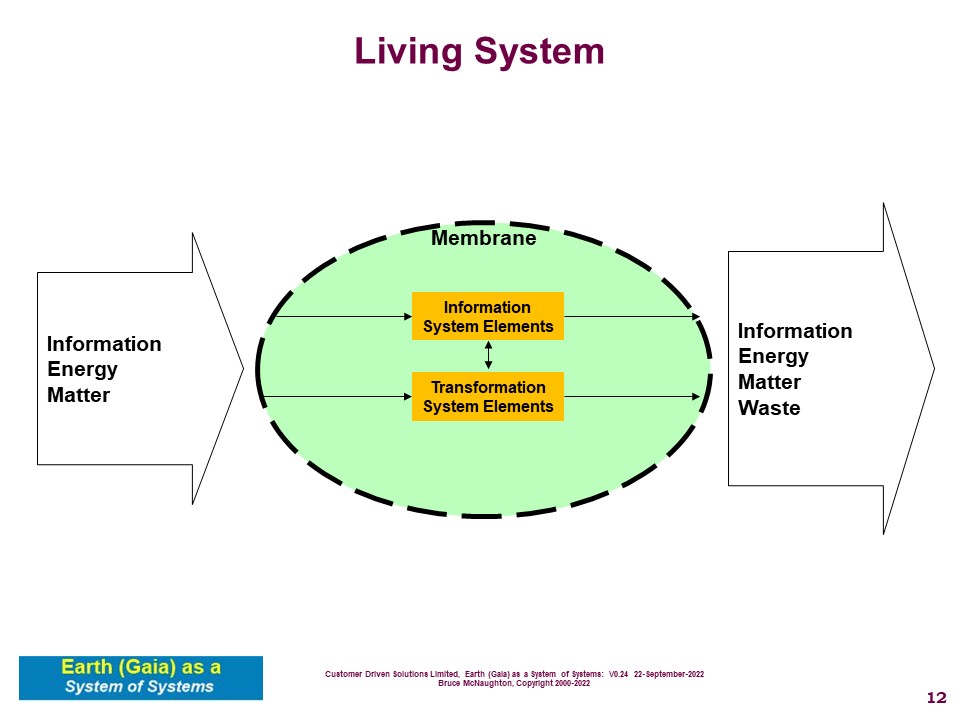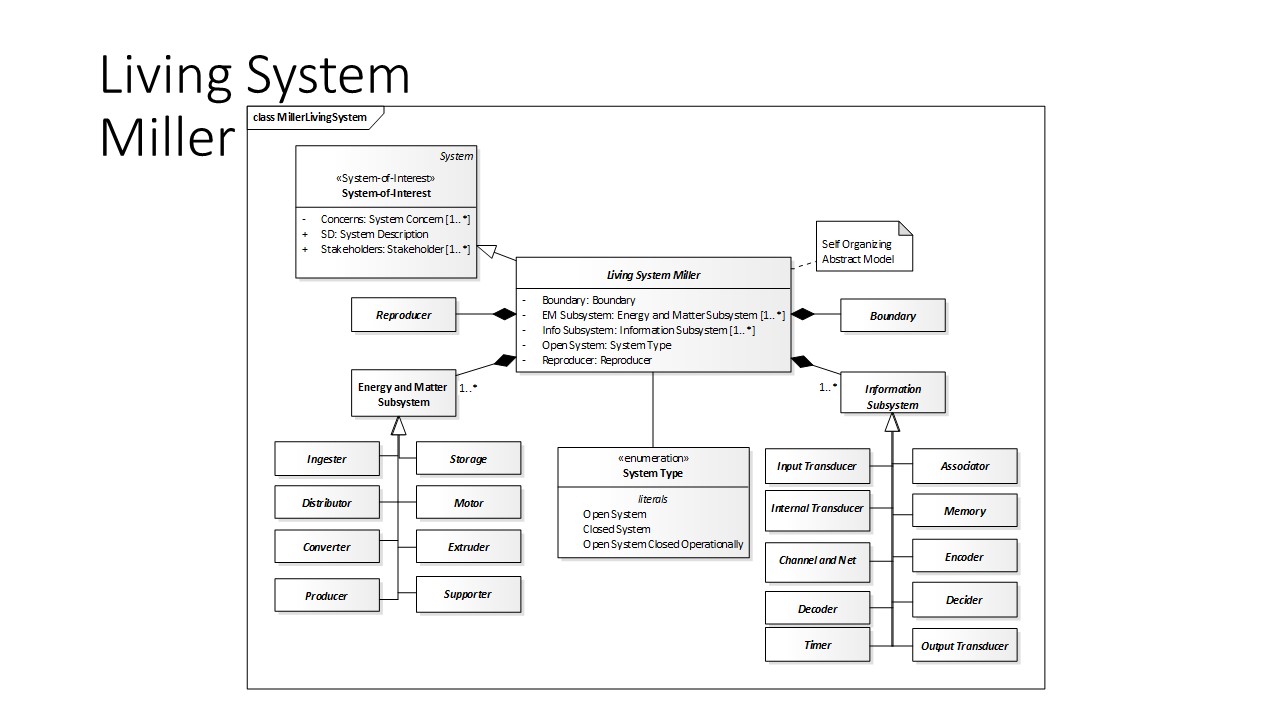Abstract System: Living System
Name: Living System
Based on: Natural System
Abstract System: This system has been identified as an abstract system that cannot be implemented directly. The abstract system establishes a shared pattern of characteristics that any system can use to describe its unique characteristics when referenced in the 'based on' list above. These references are described using a generalization association in UML.
The following are definitions used in this system description
- Life
- Metabolism
- Autopoiesis
- Health
A living system is a system that is alive. An autonomous autopoietic system.
The purpose of this system is:
- to create and sustain a living system.
- to live fully in a context or environment suitable for the system to sustain life
- to acquire and consume energy, matter and information at a level to sustain life.
- to maintain balance far from equilibrium
This living system may be a part of another system (A holon).
System Quantity Properties
These variables will be identified for a specific living system using this abstract class. Common quantity variables might be:
- Quantity and quality of Inflow of energy, matter and information
- Quantity and quality of the outflow of energy, matter and waste.
Systemic Quality Properties
These variables will be identified for a specific living system using this abstract class. Common quantity variables might be:
- Health Aliveness
- Closed operationally (organizationally)
Systemic Measurable Variables
These variables will be identified for a specific living system using this abstract class. Common variables might be:
- Health of the living system (to the best extent possible)
Systemic Capabilities or Functions
These capabilities will be defined for a specific type of living system using this abstract class
- These capabilities or functions are necessary to fulfil the purpose of the living system.
- These form the basic building blocks of the living system
System States
The various defined states that the system-of-interestcan be in.
- Conception
- Viable living system (from conception)
- Healthy Living System. (in a state of healthy dynamic balance)
- Living system Off-Balance (with illness)
- Dying Living System (unable to sustain life fully)
- Death.
The Living System:
-
Am I developing?
-
Am I able to fulfill my purpose?
-
Am I able to acquire sufficient energy, matter and information? Is my environment safe?
Other stakeholders as appropriate for the living system.
The environment and the potential impacts on the Living System will be included for a specific living system. .
The living system is structurally coupled to its environment through a boundary / membrane of its own making.
this section may include interactions in the areas of:
- Transactional
- Contextual
- Regulatory
- Physical environment
- Flow of energy and matter (items needed to sustain life)
The characteristic pattern of organizaiton for a living system is an autonomous autopoietic system typically consisting of::
- a network pattern of elements within a membrane
- Consisting of information elements
- Transformation elements
- A self-generating network of production processes
- Open to the flow of energy, matter and information
- a set of Dissipative structures to manage the flow of energy, matter and information.
- Closed organizationally within a boundary of its own making.
- A whole system may be a part (component) of another system (holon)
- a boundary or membrane of its own making.

Grier Miller has identified 20 types of elements in a living system.

Each of the elements identified by Grier Miller will be translated into specific system elements based upon the type of system-of-interest being explored.
The Behavior (Structural Changes) section describes a specific instance (configuration of components) of a system structure that results in systems behaviour. The system behavior includes descriptions of the following as needed:
- a specific configuration or embodiment of a system structure (pattern of organization) (e.g. specific system elements or components, their relationships)
- including any mathematical methods or characteristics of specific interaction types
- the triggers arising from a meaningful disturbance
- the process steps or sequence and any interaction in response to a specific trigger
- any models or data supporting the response along with any mathematical methods used.
- Any behavioral system or focused models (UML Diagrams, or Causal Loop Diagrams, etc.)
Configuration / Scenario:
Describes any configuration / scenario attributes for a specific system-of-interest. This may not be appropriate for all system descriptions (e.g. patterns or abstract systems).
The living system is structurally coupled to its environment and responds cognitively to disturbances from the environment. The cognitive response may ignore or take action on the disturbance. This response triggers a specific type of structural change.
- The structural changes are constrained by structural determinism. These structural changes preserve the pattern of organization of the living system.
- This cognitive response allows the system to learn and adapt through these structural changes. The structures change their state or process abilities through these changes. As a result, the living system is a cognitive, learning, adaptive system.
- This set of structural changes provides for a self-organizing and self-generating through a network of feedback and emergence.
Cyclical (Repeating / Regular) Processes
Triggers initiate a specific process within the self-generation or self-renewal network of production processes
Cyclical autopoietic processes occur.
Development Life Cycle Processes
Triggers initiate a specific process within the life cycle set of processes. These processes govern the development of the living system from conception to death. These will be unique to the living system.
These tend to be self-organizing or emergent types of processes. These may change the structure (pattern of organization) and may introduce new or novel abilities of the living system. Mechanisms for this type of innovation or emergence depend upon the type of living system and the environment.
.
The following references support this type of system-of-interest.
Book References
The Systems View of Life, Fritjof Capra and Pier Luigi Luisi